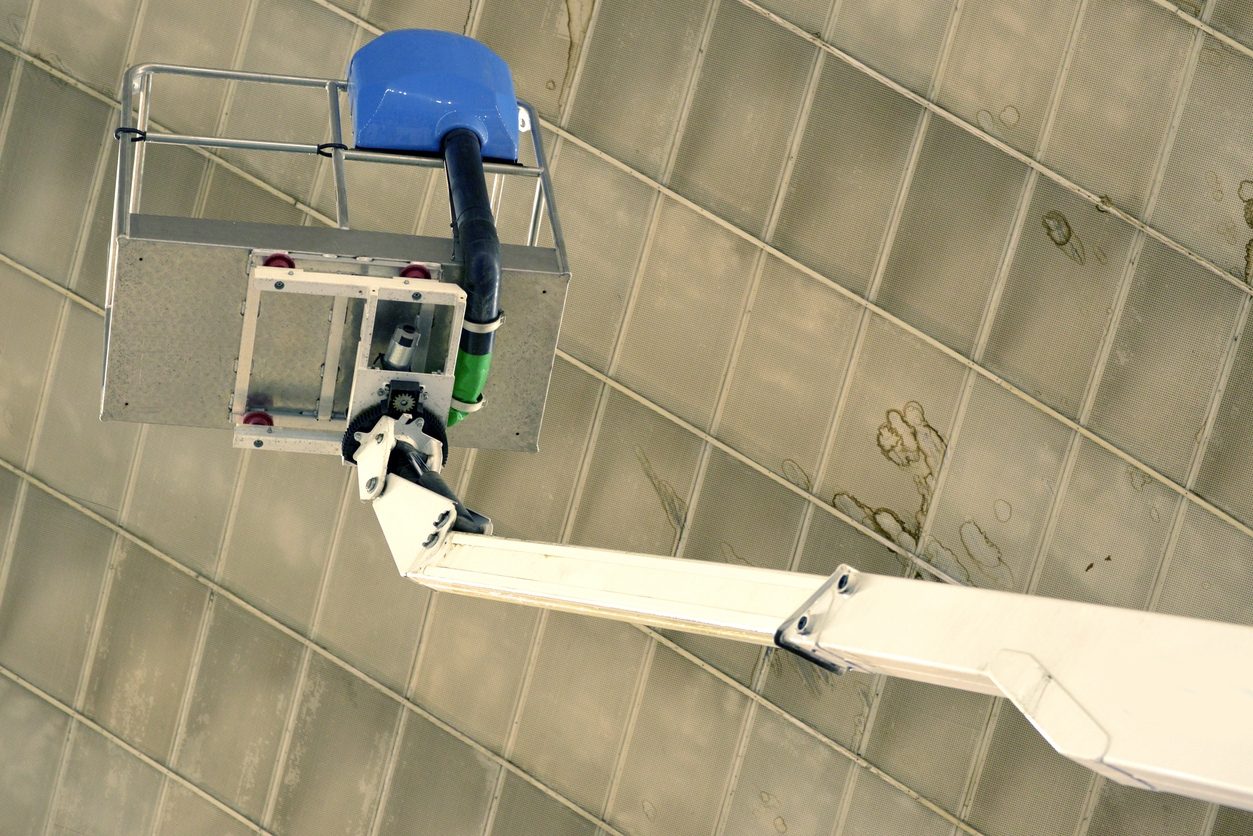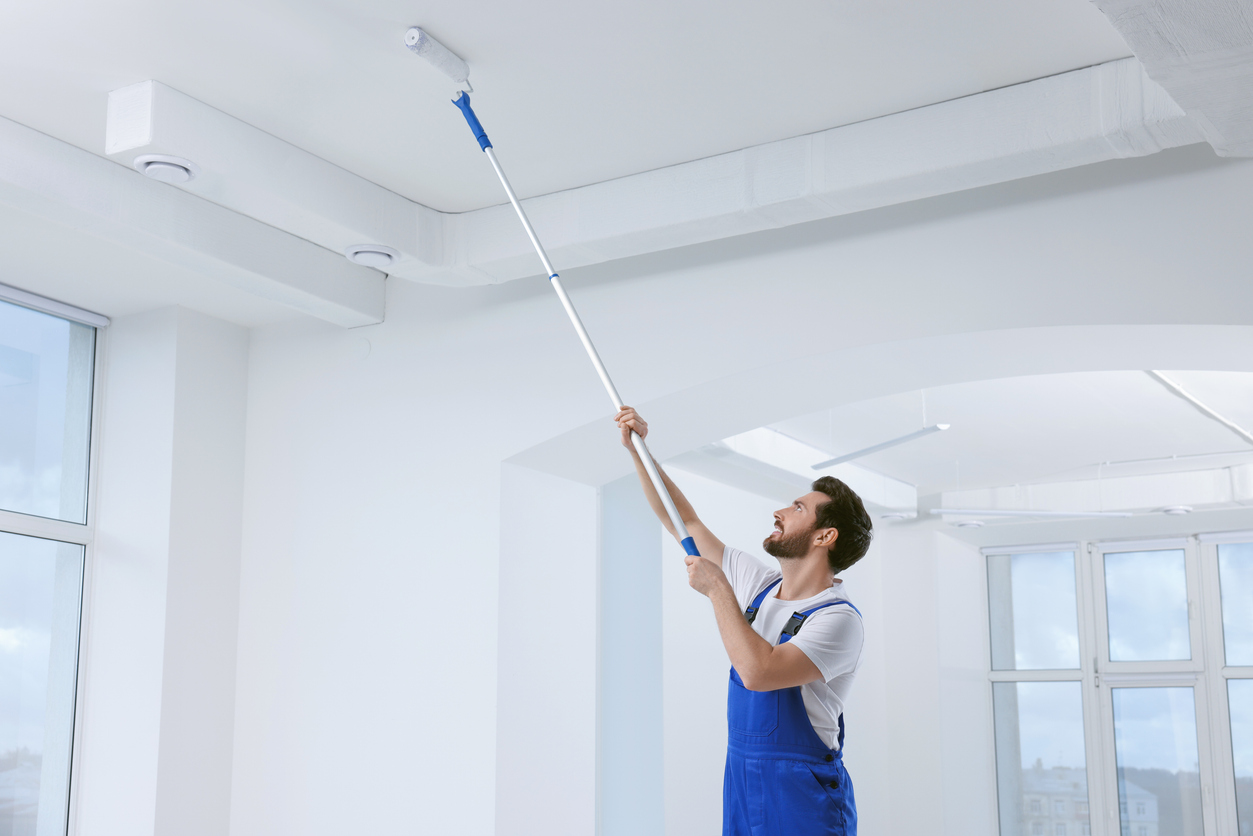Ceilings often get overlooked in interior decorating, yet they hold great potential for adding depth and style to a space. However, painting high ceilings, especially in commercial buildings in San Ramon, can be challenging due to their height and accessibility. You can also face challenges such as the need for repairing cracks in a concrete ceiling or acoustic ceiling removal.
What do commercial painters use for painting high ceilings?
Painting high ceilings in commercial buildings in the Dublin, CA area requires specialized tools, materials, and techniques to ensure safety, efficiency, and a high-quality finish. The combination of the right equipment and materials enables professional painters to achieve precise results, even in challenging and expansive spaces. Here’s an in-depth discussion of the tools and materials commonly used.
1. Tools for Access and Safety
Safety and accessibility are paramount when painting high ceilings, especially in large commercial spaces.
1. Scaffolding Systems
- Purpose: Provides a stable platform for painters to work at height.
- Features: Adjustable heights, guardrails, and wide platforms for tools and movement.
- Benefits: Safer than ladders for extended work periods, especially when covering large ceiling areas.
2. Extension Ladders
- Purpose: Used for reaching high areas where scaffolding may not be practical.
- Features: Lightweight aluminum or fiberglass construction for portability and durability.
- Limitations: Best for smaller areas due to limited stability compared to scaffolding.
3. Aerial Lifts (Boom Lifts or Scissor Lifts)
- Purpose: Provides mobile, elevated platforms for reaching very high ceilings.
- Features: Electric or gas-powered, adjustable height settings, and safety harnesses.
- Benefits: Ideal for expansive spaces like warehouses or auditoriums, where mobility is key.
4. Personal Protective Equipment (PPE)
- Safety helmets, harnesses, gloves, and non-slip footwear are essential for working at heights.
2. Application Tools
Using the right application tools ensures even coverage and minimizes waste.
1. Extension Poles
- Purpose: Extends the reach of rollers and brushes.
- Features: Lightweight and adjustable, often made of fiberglass or aluminum.
- Benefits: Reduces the need for ladders or lifts in moderately high areas.
2. Airless Paint Sprayers
- Purpose: Speeds up the painting process, especially for large, open spaces.
- Features: High-pressure systems that spray paint evenly without requiring thinning.
- Benefits: Ensures uniform coverage, reduces overspray, and can handle thicker paints like primers.
3. Paint Rollers
- Purpose: Applies paint to large flat surfaces like ceilings.
- Features: High-nap rollers for textured ceilings and low-nap rollers for smooth surfaces.
- Benefits: Ideal for touch-ups or areas where sprayers are not feasible.
4. Angled Brushes
- Purpose: For cutting in along edges, vents, or light fixtures.
- Features: Tapered bristles for precision.
- Benefits: Ensures clean lines and reduces the need for masking.
3. Paint and Coating Materials
High ceilings in commercial spaces often require specific paint types and coatings tailored to the environment.
1. High-Quality Ceiling Paint
- Features: Matte or flat finish to reduce glare and hide imperfections.
- Types: Stain-blocking paints for areas prone to moisture or smoke.
2. Primers
- Purpose: Prepares the surface for paint, ensuring adhesion and durability.
- Features: Stain-blocking, fast-drying, and compatible with various ceiling materials like concrete, plaster, or metal.
3. Specialized Coatings
- Fire-Resistant Paint: Used in compliance with safety regulations in commercial buildings.
- Acoustic Coatings: For spaces like theaters or conference rooms to reduce noise reverberation.
- Reflective Paints: Increases light reflection, which is ideal for warehouses and factories to reduce lighting costs.
4. Auxiliary Tools
Supporting tools enhance precision and efficiency.
1. Drop Cloths and Plastic Sheeting – Protect furniture, flooring, and walls from paint splatters.
2. Masking Tape – Ensures clean lines around edges, vents, and fixtures.
3. Paint Buckets and Grids – Simplifies paint loading for rollers and prevents spills.
4. Lighting Tools – Portable work lights illuminate high ceilings, ensuring even application.
5. Preparatory and Maintenance Tools
Proper preparation and maintenance of tools are critical for a professional finish.
1. Surface Preparation Tools – Scrapers and Sanding Blocks are used for removing old paint or smoothing imperfections. Power Washers are used for cleaning ceilings before painting, especially in industrial settings.
2. Paint Mixers – Ensures uniform color and consistency, especially for large quantities of paint.
3. Cleaning Equipment – Solvents and cleaners for sprayers and brushes to ensure longevity and performance.
6. Advanced Technology and Equipment
Modern advancements in painting technology further improve efficiency.
1. Automated Spraying Systems- Robotic systems for very high or hard-to-reach ceilings in large commercial facilities.
2. Laser Alignment Tools – Ensures straight lines and accurate paint application in geometrically complex spaces.
3. HEPA-Filtration Systems – Used with sprayers to minimize airborne paint particles, ensuring a clean working environment.
Challenges and Solutions
Challenge: Managing overspray with sprayers.
- Solution: Use sprayers with adjustable nozzles and practice controlled spraying techniques.
Challenge: Ensuring safety at great heights.
- Solution: Comprehensive training for painters on lift operation and fall protection protocols.
Challenge: Painting in occupied commercial spaces.
- Solution: Use low-VOC or no-VOC paints to minimize odors and disruptions.
Leveraging these tools and materials allows professional painters to handle the complexities of high ceilings in commercial buildings efficiently and safely, delivering durable and aesthetically pleasing results.
Surface preparation
As professional painting contractors, they take surface preparation very seriously in commercial property. Surface preparation is critical when painting high ceilings in commercial buildings to ensure a durable, high-quality finish and long-term performance. Here’s why it’s important:
- Ensures Adhesion: Properly cleaning and priming the surface removes dirt, grease, or residues that prevent paint from adhering correctly, reducing the risk of peeling or flaking.
- Reveals Surface Defects: Prepping the surface, including inspecting and repairing cracks, dents, or uneven areas, creates a smooth and professional finish.
- Prevents Contamination: Dust and other particles on high ceilings can interfere with paint application. Cleaning the surface ensures consistent coverage and appearance.
- Enhances Durability: Using primers and sealants appropriate for the material improves the paint’s resistance to wear and environmental factors, such as humidity and temperature fluctuations.
- Saves Time and Costs: Proper preparation reduces the need for rework, minimizing downtime and costs associated with premature paint failure.
Effective preparation might include cleaning, sanding, patching, priming, and using scaffolding or lifts to ensure safety while working at heights.
Reasons to paint high ceilings
Painting high ceilings in commercial properties serves several important purposes:
- Aesthetic Appeal: A well-chosen ceiling color can enhance the overall design, creating a cohesive look that aligns with the property’s branding or desired ambiance.
- Space Perception: Light colors can make the space feel open and airy, while darker tones can create a more intimate atmosphere by visually lowering the ceiling.
- Concealing Imperfections: Painting can hide flaws, ductwork, or other structural elements, especially in exposed or industrial-style ceilings.
- Improved Lighting: Light-reflective paints can optimize lighting, reducing the need for additional fixtures and creating a more inviting environment.
- Zoning and Wayfinding: Different ceiling colors can delineate areas for specific functions, aiding navigation in large properties like warehouses or retail spaces.
- Energy Efficiency: Reflective paints can help manage temperature, contributing to heating and cooling efficiency in large spaces.
- Brand Identity: Custom ceiling colors can reinforce the brand’s color scheme, contributing to a unified visual identity.
Strategic ceiling painting enhances functionality, comfort, and visual impact in commercial properties.
The benefits of using proper tools
Using proper tools to paint high ceilings in commercial settings offers several benefits:
- Efficiency: Tools like extendable rollers, spray painters, and scaffolding expedite the process, reducing time and labor costs.
- Safety: Using tools such as sturdy scaffolds, ladders with safety features, and telescopic poles minimizes the risk of accidents, ensuring worker safety.
- Precision: High-quality tools help achieve a smooth and even finish, avoiding streaks or patches that can occur with improper equipment.
- Accessibility: Extendable tools and lifts allow painters to reach high or awkward spots without compromising quality.
- Cost-effectiveness: Investing in the right tools reduces the need for touch-ups and repainting, saving money in the long term.
- Professional Results: Proper tools deliver a polished and professional appearance, enhancing the commercial space’s overall aesthetic appeal.
Final words
Painting high ceilings in commercial buildings is challenging because it involves working at varying heights. It takes more than skills and experience to paint high ceilings. It also requires the proper tools, equipment, and safety gear. The best commercial painters should have all these attributes to complete this (literally) high job safely and successfully.
Custom Painting, Inc. offers the best painting solutions for your commercial building or industrial facility. Contact us today at 925-866-9610 or on our contact page to discuss your painting project in detail!



